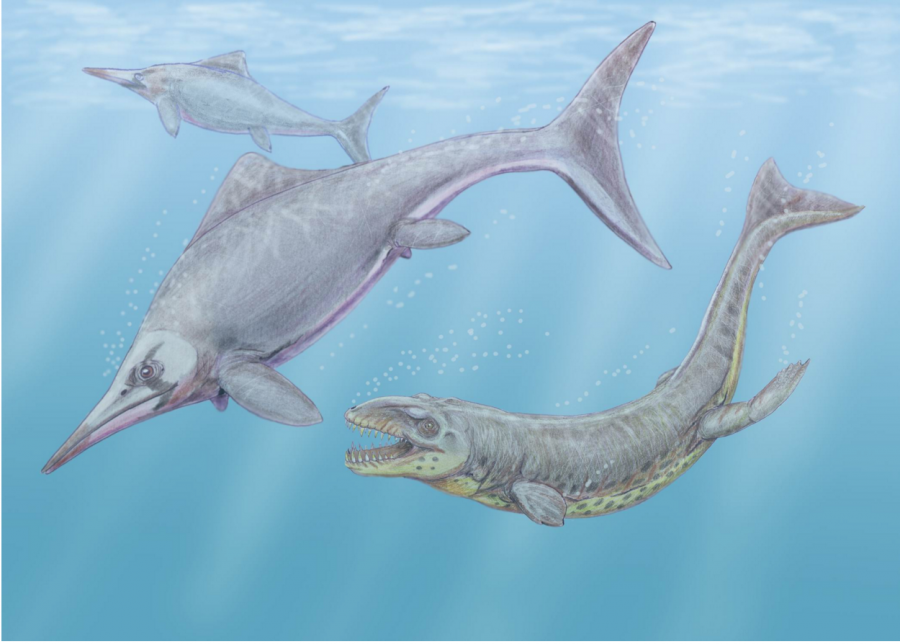Real Life Sea Monsters
This artist’s interpretation of the jurassic ocean shows the ichthyosaurid Caypullisaurus being ambushed by the crocodylomorph Dakosaurus
During the Age of Dinosaurs (the Mesozoic) the oceans were dominated by a diverse array of marine reptiles that filled the ecological roles in which we today find whales, dolphins, seals, and various large fish. They were not true dinosaurs, and in fact came from very disparate groups of reptiles. However, their rise to diversity and dominance in their environment parallels that of the dinosaurs, from humble beginnings in the Triassic to their near complete eradication 66 million years ago at the end of the Cretaceous. Although they were very diverse, there are some key traits of all currently known marine reptiles that set them apart from their mammalian equivalents. Firstly, there is no known marine reptile that fed on plankton, as baleen whales do. This role was filled in their environments by some truly massive fish species, which resembled the modern whale shark in shape and habit but were not sharks. Secondly, it is thought that marine reptiles were not warm blooded like the dinosaurs, and did not have layers of fatty blubber as marine mammals do. This meant that marine reptiles were only capable of living comfortably in tropical and temperate oceans. Fortunately for them, the climate during the mesozoic was consistently more that 10º warmer than modern temperatures, which enabled their ranges to reach up to and even into the polar zones.
In the Triassic, the first period of the Mesozoic from 252 to 201 million years ago, diverse forms of marine reptile took to the ocean for the first time. During the Triassic the Earth’s ecosystems recovered from the ravages of the Permo-Triassic Extinction, the largest extinction that has yet occurred. This event swept the seas clean of an ecosystem in which the large predators were sharks, sea scorpions, armor plated fish, and armored relatives of the squid. Of these primordial hunters, only the sharks and squids still existed and they were greatly diminished from their glory days. A profusion of amphibious reptiles colonized the coastal waters, where they developed streamlined bodies and sharp puncturing teeth like those of seals to prey on fish and invertebrates. Some became agile and powerful like the Nothosaur, with teeth that bent outwards to cage in fish. Others developed strange new body forms like the slow and gawky Tanystropheus, which had a body the size of a garbage can and a neck longer than a car. Still others developed unique ways of feeding, like the buck toothed Placodus, which cracked open the shells of clams and mussels. These diverse creatures would quickly come to share their home with another group of marine reptile, even more perfectly adapted to the water. These were the ichthyosaurs, which translates quite appropriately to fish lizard. These reptiles developed bodies very much like that of fish or dolphins, with flippers instead of webbed feet, no visible neck, and dorsal and tail fins like those of fish. Their major innovation which allowed them to colonize the water so effectively was their ability to give birth to live young. They did this in a manner similar to that used by some sharks: The mother simply never lays her eggs until the very end of their development. When the eggs are prepared to hatch they are broken immediately as they are laid, and the baby rushes out to surface for its first breath of air (or not in the shark’s case). With this method the Ichthyosaurs colonized the world’s oceans very quickly, and diversified into various forms. The most successful would prove to be those who become dolphin like fast predators, with barrel like bodies and relatively small body size (5-20 feet long). Other varieties grew into whale-like giants, like the orca sized predators Cymbospondylus or the 60 foot long Shonisaurus and Shastasaurus, the first true giants of the ocean. The Ichthyosaurs had a big world to expand into: during the Triassic all land on the planet was concentrated into the supercontinent of Pangaea, and all the world’s oceans into the Panthalassic Ocean. This ultimate ocean was deep and dark, probably wracked by the vast storms that form over oceans like today’s Hurricanes and Typhoons. But it was not eternal, as shifts in the tectonic plates began to break apart Pangaea at the end of the triassic, bringing verdant new shallow seas and competition for the ichthyosaurs.
During the Jurassic (from 201 to 145 million years ago), new families of marine reptiles joined the ichthyosaurs to create a more biodiverse ecosystem. The Jurassic began a period of rapid seafloor spreading that would continue throughout most of the mesozoic. Seafloor spreading is the constant process in which the abyssal crust is created at the volcanic trenches deep under the ocean and pushed out away for millions of years at an imperceptibly slow rate, to eventually reach the continental crust and slide under it and back into the molten mantle. When this process speeds up it increases the rate at which the continental crust is pushed around and raises the sea level dramatically. This process made the Jurassic and Cretaceous a global environment for the marine reptiles, while also helping to isolate the dinosaurs to allow them to achieve their amazing diversity. Inland seas intersected what is today North America and Africa, and most of Europe was underwater. During the Jurassic three new groups of marine reptile evolved to take niches once held by ichthyosaurs. At the end of the Jurassic only the dolphin-like Ichthyosaurs still roamed the seas, but they were largely uncontested for dominance of their niche. The first group was the marine crocodylomorphs. Close relatives of modern crocodiles and for all intents and purposes crocodiles with flippers, these species would not grow to massive sizes but instead became filled many niches as sharklike predators hunting small and medium sized prey. The other two groups were the plesiosaurs and pliosaurs, who were both very closely related and closely related to the ichthyosaurs. Their ancestry lay in some of the triassic coast dwellers who were closely related to ichthyosaurs. They probably had begun to evolve into their iconic forms during the late triassic Both of these groups developed barrel shaped bodies with four sturdy flippers and a short tail, a shape like that of the sea turtles. Unlike Ichthyosaurs, they only developed live birth after millions of years colonizing the oceans, and so no matter how far they wandered they were still tied to land like sea turtles for much of their history. Plesiosaurs developed their iconic long necks, and became the top fish hunters in coastal waters. They grew in size up to thirty feet long, which allowed them to defend themselves against beachcombing predatory dinosaurs. Pliosaurs grew even larger and grew huge maws with puncturing teeth like those of orca whales. They were top predators, truly frightening animals. Between these species and the sharks, the apex niches in marine ecosystems were filled with a diverse and monstrous menagerie, which was complemented by a continuing diversity of amphibious species.
In the Cretaceous, the continued tropical climates and high sea levels led the marine reptiles to continue their success up to the very end of the age of dinosaurs. During the first half of the Cretaceous especially the sea levels were extremely high, the highest they’ve been in the history of life on Earth so far. It was during this time that Pliosaurs and Plesiosaurs diversified and began to outcompete Ichthyosaurs and marine Crocodylomorphs, especially with the evolution of a new group of massive Plesiosaurs called Elasmosaurids, which could grow up to 50 feet long. The Pliosaurs also grew to their largest sizes in the Cretaceous, with the Kronosaurus reaching a size equivalent to the biggest Elasmosaurids. By the second half of the Cretaceous the Ichthyosaurs and marine Crocodylomorphs had gone extinct, but they were replaced with new varieties of marine reptiles. The first was the Sea Turtles, of which the largest was the car sized Archelon, which lived in the shallow seas that filled America’s great plains. The second and more diverse were the Mosasaurs, marine relatives of the monitor lizard with a sinuous body like a lizard or snake and powerful flippered legs. It is unknown if these species developed live birth, but some recent discoveries have indicated that they developed this ability in a case of parallel evolution with the Ichthyosaurs. They were largely predatory, and ranged in size from only a few feet long to their largest forms such as Tylosaurus and Mosasaurus, which were upwards of 50 feet long. Some of their species developed unique methods of hunting, such as the Globidens, which had blunt peg teeth to crunch shellfish. They were potent competition for the bulkier yet stronger pliosaurs, but they had one unique trait that set them apart. Many Mosasaurs had a secondary set of jaws with its own set of teeth inset far back in their mouths. These teeth do not have much movement independent of the main jaw, but enough to allow them to hold prey in place between bites from the main jaw. Mosasaurs never fully replaced Pliosaurs as the top marine predators, but they did colonize all the world’s oceans alongside them. They had reached their zenith just before the End Cretaceous Mass Extinction, but the sea levels began to fall back to their normal level shortly before then, coupled with the beginnings of a thirty million year long cooling that would result in the ice caps forming at the poles during the middle of the age of mammals. The time in which marine reptiles dominated the oceans may have come to a close without the meteor or the mass volcanic eruptions, but they precipitated their fall and brought it to a sudden close. They were not the only creatures to be hard hit by the disaster, but as the top of the food chain they could not survive in the barrenness and pollution that followed it. Their age ended, but nature does not allow ecosystems to remain empty long, and within fifteen million years the first whales had evolved to fill their niches, and the sharks had evolved into new forms to join them at the top of the food chain. In this too their evolutionary history was parallel to dinosaurs, and just like the dinosaurs only one group from amongst their numbers was not wiped out: the sea turtles.











Whitney Xu • Feb 17, 2016 at 9:43 pm
I hope your next article is about sea turtles